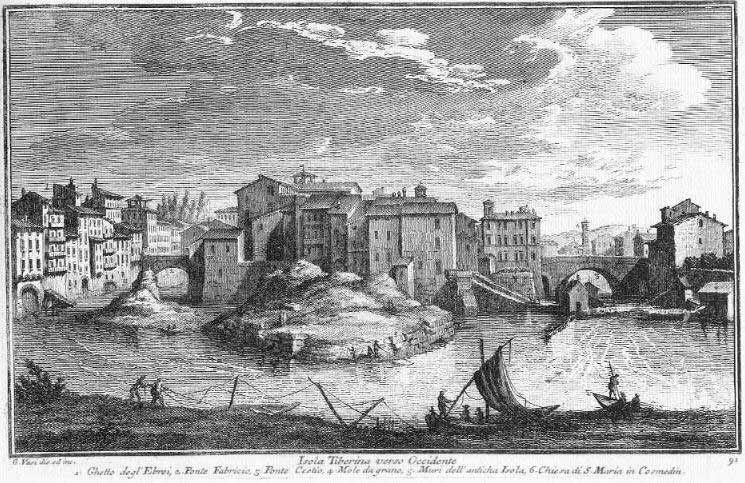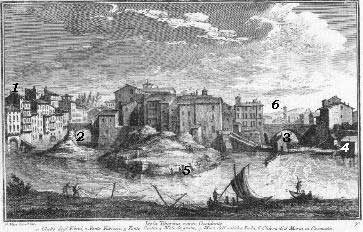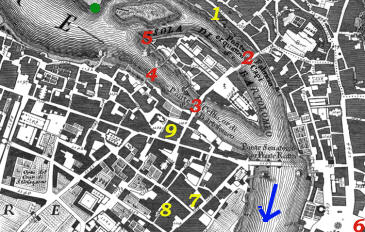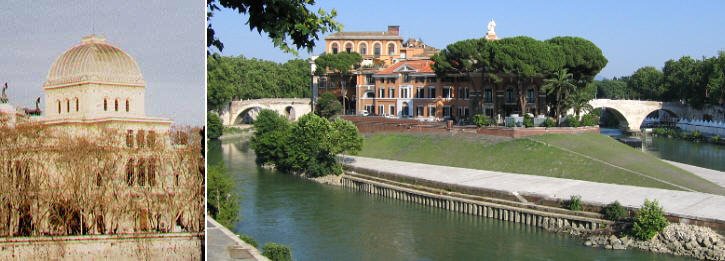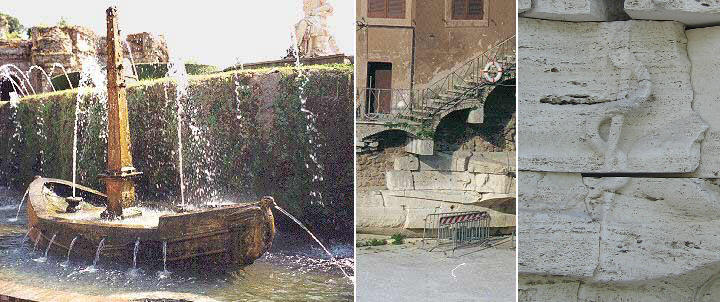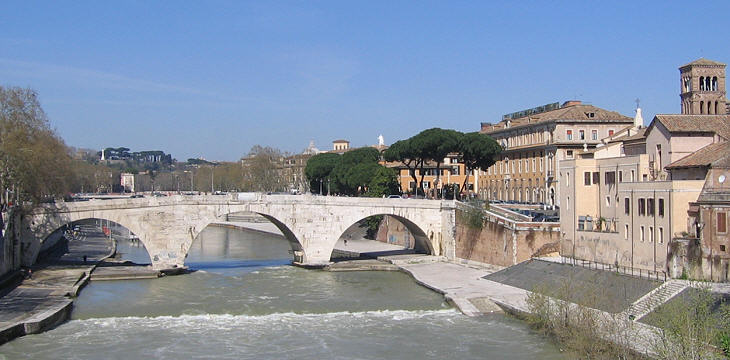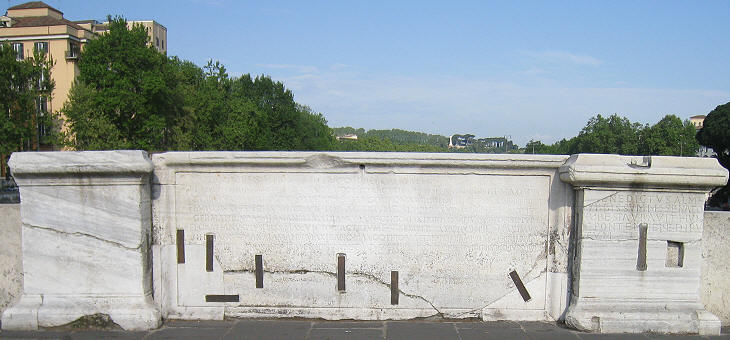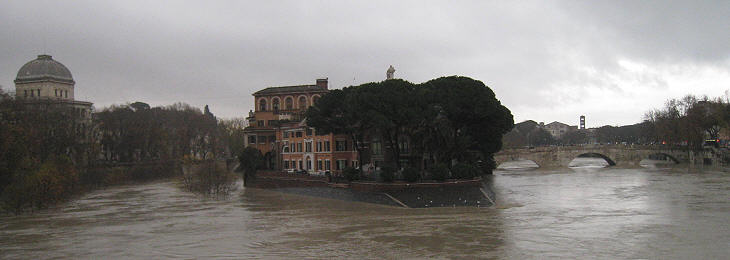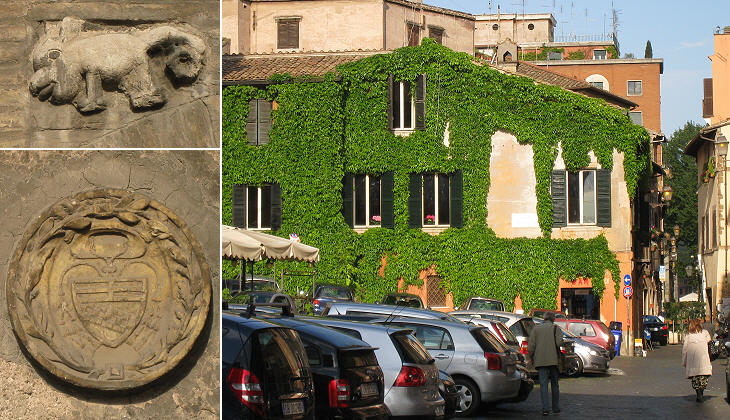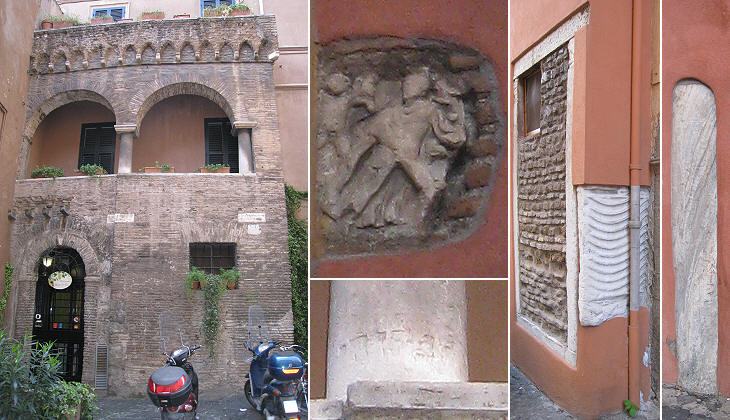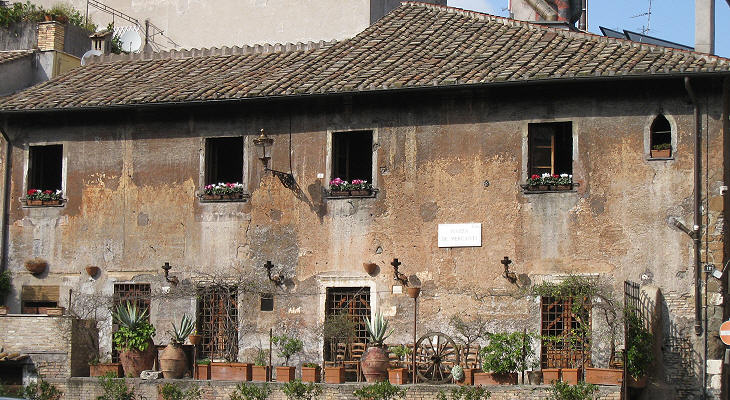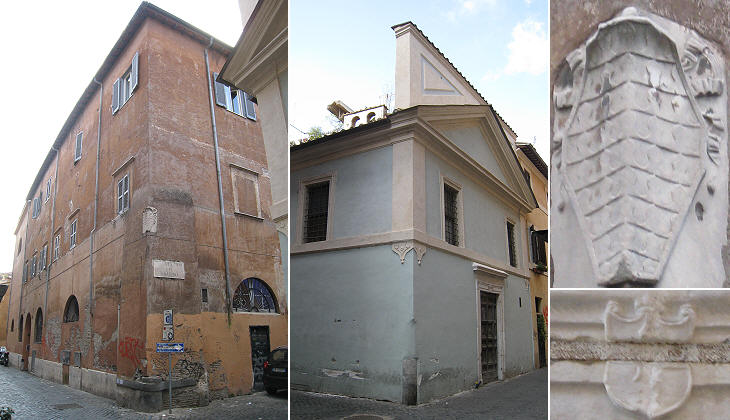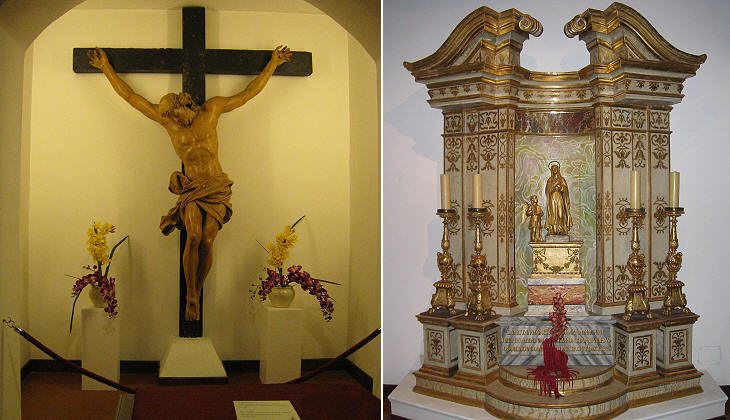  What's New! Detailed Sitemap All images © by Roberto Piperno, owner of the domain. Write to romapip@quipo.it. Text edited by Rosamie Moore. Page revised in May 2009. | Isola Tiberina verso Occidente (Book 5) (Map C3) (Day 5) and (Day 6) (View C9) (Rione Ripa) and (Rione Trastevere) In this page: The plate by Giuseppe Vasi Today's view Ponte Cestio Via dell'Atleta and a walk through Ripa Romea (Palazzo Mattei di Trastevere) S. Andrea dei Vascellari and Casa dei Ponziani The Plate (No. 91)
On the left Vasi shows the houses of the Jewish Ghetto overlooking the river like a Little Venice. The view is taken from the green dot in the small 1748 map here below. In the description below the plate Vasi made reference to: 1) Ghetto degli Ebrei; 2) Ponte Fabrizio; 3) Ponte Cestio; 4) Mole da grano (mill); 5) Ancient walls; 6) S. Maria in Cosmedin. 1), 2) and 6) are shown in detail in other pages. The map shows also 7) S. Andrea dei Vascellari; 8) Via dell'Atleta; 9) Palazzo Mattei di Trastevere.
Today
The view is today mainly a view over the Jewish Synagogue built in 1904 on the site of the old Ghetto and Spedale di S. Giovanni di Dio o Fatebenefratelli. Isola Tiberina resembles a ship ready to leave, but restrained by the two bridges. The form of the ship was very much emphasized during the Roman Empire by building an external travertine wall and by erecting at the center of the small island an obelisk as a sort of mast.
A small section of the travertine wall still remains at the eastern tip of the island (the plate by Vasi shows it also at the western one). It is decorated with a relief portraying a snake wrapped around a stick, the symbol of Aesculapius (Gr. Asclepius), the god of Medicine, to whom the island was sacred. A Renaissance representation of Isola Tiberina can be seen in a detail of the fountain called Rometta (Little Rome) at Villa d'Este in Tivoli. Ponte Cestio
Ponte Cestio was built in 46 BC by the consul Lucius Cestius. In 370 AD it was almost entirely rebuilt by Emperors Valens, Valentinian I and his son Gratian. The bridge was often referred to as Ponte Graziano.
A large inscription celebrates the three emperors and their victories over the Germans, the Alamanni, the Franks and the Goths; this long list is by itself an indication of the growing difficulties the Roman Empire was experiencing on its northern border. The quality of the inscription is poor when compared to other Roman inscriptions and it is barely readable. Next to it a smaller inscription celebrates a restoration in 1192 by Senator Benedetto Carushomo. The inscription, which attempts to imitate that of the emperors, is a sign of the power achieved by the municipality of Rome towards the end of the XIIth century. Senator was the title given to the head of the city government. Carushomo was overthrown after just two years in office. The execution of the inscription shows a lack of skill with words split into two lines and without the central alignment which characterized the ancient inscriptions. BENEDICTUS ALME/URBIS SUMME SENATO/R RESTAURAVIT HUN/C PONTEM FERE DIRU/TUM (Benedict, the great Senator of the famous city repaired this bridge which was falling into ruins). Those who are interested in the text of the emperors' inscription can find it at the very end of the page.
In 1888-92 the bridge was modified by enlarging the lateral arches to reduce the risk of floods. Learn more about the Tiber floods. Via dell'Atleta
The Mattei are a family whose fortunes date back to medieval Trastevere. A branch of this family built a large palace, near S. Maria in Campitelli, while another branch continued to live in a medieval house (partly modified) in Trastevere opposite S. Benedetto in Piscinula.
This part of Trastevere is not as popular as the area near S. Maria in Trastevere, but its houses covered with ivy and other creeping plants appeal more and more to the rich.
The part of Trastevere beyond Ponte Cestio was known in the Middle Ages as Ripa Romea which meant Pilgrims' Bank as Romeo stands for pilgrim going to Rome. The river harbour of Ancient Rome was on the left bank in Testaccio. For the reduced population of medieval Rome Testaccio was too remote and in the XIth century the ships coming from the sea started loading their goods on the right bank (i.e. Trastevere) near Isola Tiberina. Ripa Romea was mainly populated by foreigners, pilgrims, merchants and by the Roman Jews, whose Temple (with a fine loggia) was in a little alley. This alley was subsequently called Via dell'Atleta because in 1844 a Roman statue was found in this street. It showed an athlete (Apoxyomenos) in the act of using a skin-scraper (strigil). It is now in the Vatican Museums. In the alley, in addition to a small Roman relief which is thought to represent an athlete, there are pieces of Roman columns or sarcophagi which were used to decorate the buildings.
The small houses and the stables close to the river are now picturesque trattorias. S. Andrea dei Vascellari
The names of the streets of this part of Trastevere confirm that in the XIIth century the area was very busy: Via dei Salumi (salted meat), Via dei Vascellari (potters), Via dei Genovesi (Genoese merchants), Piazza dei Mercanti (merchants) are all names given in that period. The church of S. Andrea dei Vascellari (now deconsecrated) was built in the IXth century and later on it was acquired by the guild of the butchers and in the XVIIIth century by the guild of the potters (for a list of the churches belonging to a guild, click here). The building next to it is the medieval house of the Ponziani, a family of butchers who became very important in the XIVth century. The greatest saint of Rome, Santa Francesca Romana, the founder of Monastero di Tor de' Specchi, married a member of this family.
Casa dei Ponziani is today a house for (wealthy) pilgrims with a chapel and meeting halls which are decorated with fine works of art. Excerpts from Giuseppe Vasi 1761 Itinerary related to this page:
Next plate in Book 5: S. Bartolomeo all'Isola You have completed Day 5 itinerary! Move to Day 6. Next step in your Day 6 itinerary: Chiesa di S. Salvatore a Ponte Rotto Next step in your tour of Rione Ripa: Spedale de' Benfratelli e Chiesa di S. Giovanni Calibita
|
